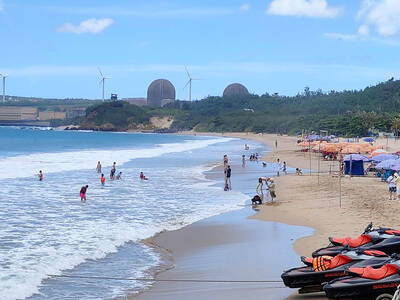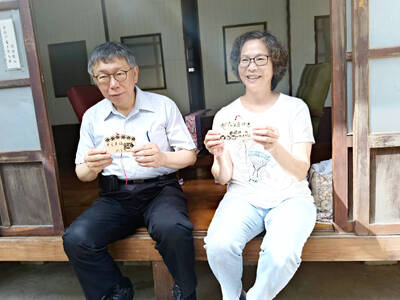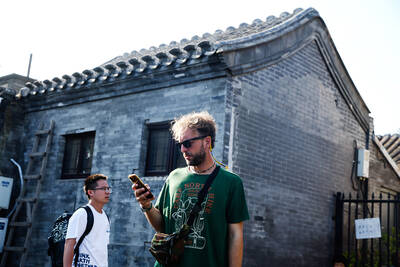“I went to see the Great Wall. You know, you read about it for years. And actually, it was really great. It was really, really, really great.”
That was Andy Warhol after his only visit to China, in 1982.
He loved what he saw. He loved, he said, that everyone here dressed alike. He loved that the Great Wall, the world’s biggest Private Property: Do Not Enter sign, was in a Communist country. He loved that Mao Zedong (毛澤東), whose face he had painted because Life magazine called Mao the most famous man in the world, was still a superstar even though he had been dead for six years.
China was Pop. It still is. It’s still a nation of uniforms, but of more and more kinds of uniforms. I saw outfits with matching corsages on department store salesgirls, the slate-gray shirts of guards stationed at luxury high-rises and the Chloe Sevigny T-shirts that teenagers wear on Beijing streets. Mao’s image is less conspicuous here than it once was. His status took a dip when the savageries of the Cultural Revolution began to be told. His face doesn’t appear on a new 10 yuan banknote issued for the Olympics, but it’s on all other currency above the small-change level. He remains omnipresent, like some Warholian multiple. Look and you’ll find him. His star power holds.
And there’s advertising on top of advertising. Next to the stretch of the Great Wall that Warhol visited — actually a modern reconstruction, fake history — there now stands a large billboard emblazoned with the Olympic slogan, “One World One Dream.” It simultaneously promotes an image of the New China and interrupts a view of the old one, a vista of a romantic landscape that has been kept, for travel-brochure purposes, development free.
Warhol knew all about new-old. He didn’t paint Campbell’s soup cans because they were so cool and 1960s but because they were homely and 1930s, relics of his Depression-era childhood. He would have grasped in a flash that there’s something very old right in the center of the splashy new Beijing: a cemetery, a symbolic one but a cemetery nonetheless.
It has three parts: Mao’s mausoleum, where he lies in state; the Forbidden City, where the nation’s imperial past is embalmed; and, between them, Tiananmen Square, where the ghosts of a still-recent political trauma, the 1989 massacre of pro-democracy demonstrators, find no rest.
Of course Warhol had himself photographed with the Mao portrait in Tiananmen. Whether he toured Mao’s mausoleum — officially the Chairman Mao Memorial Hall (毛主席紀念堂) — I don’t know. I knew I wanted to go. The problem was finding a companion. Several expatriate contacts begged off. None of them, it seemed, had ever made a visit, and they wondered why I would want to.
I tried to explain that, with my interests in popular culture, popular religion, power politics and the mechanics of propaganda, not to mention Pop Art and Chinese history past and present, the mausoleum was a must-see. Doubtful glances. Finally a young art consultant and translator named Megan Connolly, a native New Yorker living in Beijing, agreed to go. Warning me wryly that she had never been to the Statue of Liberty, she booked a car for an early morning pickup.
Our driver, Yang Jie, was a find. In her mid-30s, she reminded me of Diana Rigg as Emma Peel in The Avengers. Driving her own SUV, she handled traffic as one imagines Emma might, with bold but diffident grace. Firm of opinion, up on the news, she was an utterly cosmopolitan person, although she spoke only Chinese and had seldom left Beijing.
She drops us off a block from Tiananmen Square, where security, unrelenting since 1989, is tighter since the recent unrest in Tibet and protests over shoddy school construction after the May earthquake. Police officers, in and out of uniform, patrol the area. Soldiers of the People’s Liberation Army, in crisp olive-green, parade in front of Mao’s tomb as Connolly and I get in line.
Just the day before, I rubbed shoulders with olive-clad soldiers crowding a government-organized exhibition called Tibet: Past and Present at the Cultural Palace of Nationalities. The show, enthusiastically covered in the Chinese news media, was presented in two thematic parts.
The first, called The History of Tibet and Feudal Serfdom in Old Tibet, consisted mostly of old photographic images of what the labels said were peasants maimed and crippled at the hands of Tibetan lords and Buddhist lamas. The second, New Tibet Changing With Each Passing Day, was a full-color travelogue account of the country under Chinese rule, an idyll of progress and cheer.
The whole business was a classic exercise in propaganda, so blatant as to verge on kitsch. And it felt familiar. We get similar shows on Tibet and China in the West, in only slightly more nuanced form, with the good guys and bad guys switching roles.
At the mausoleum the entry line is long. Most of the people, it seems, are members of Chinese tour groups, out-of-town families or knots of friends on patriotic pilgrimage. No one projects Yang’s urbane internationalist flair. At the same time there are quite a few young people, students by the look of them, some in their teens, others a little older, casually dressed in slacks and jeans, and quiet.
Waiting gives us a chance to survey the mausoleum exterior. A colonnaded stone cube with a Chinese-red tiled roof, it was built in 1977 and has the bland, boxy, buttoned-up look of a Mao jacket. Its impression of grounded bulk seems exactly the opposite of what the new National Stadium, the Bird’s Nest (鳥巢), with its curves and transparencies, is out to convey, though at least one public figure in China disagrees.
The artist Ai Weiwei (艾未未), who was a consultant on the stadium’s design and is one of the few anti-authoritarian voices in a politically docile Chinese art establishment, has said that the concoctions for the Olympics are only cosmetically different from official design. Both, in different ways, affirm the continuance of one-party rule, he says, and the repression that implies. “There is no New China,” he concludes.
The line at the mausoleum entrance starts to move. The guards are practiced at processing visitors, sizing them up, moving them forward. We enter a shedlike enclosure. Cameras and cellphones must be put away or left behind. We walk through metal detectors. Police in navy blue double-check us with scanners, then pat us down before directing us out the door.
We are in the entrance courtyard, where I am surprised to find a small floral concession, a kiosk selling two kinds of bouquets: one made up of a single rose wrapped in cellophane and thin as a baton; the other, a bunch of gladioluses also tightly wrapped. People dart over to make a purchase, one per customer, and dart back to take their places as the line moves ahead.
Then we are in a high-ceiling reception hall, and, somewhat startlingly, Mao is straight ahead: a white marble statue seated in a thronelike chair, face forward. The figure seems clearly modeled on the Abraham Lincoln by Daniel Chester French in Washington except that where Lincoln looks somber, aged and lost in thought, Mao is youthfully alert, his face raised and faintly smiling.
I flash back to the ocean of Mao statuettes I just saw at Panjiayuan (潘家園), Beijing’s art flea market. White, red, green and pink Maos. Mao in plaster, stone and bronze. Mao sitting, standing, striding, waving. Mao relaxing with a cigarette; Mao in a bathrobe, ready for a dip. The figures were being hawked as Cultural Revolution-era collectibles, but most, I gathered, were new. So were copies of Mao-related paintings by hot contemporary artists like Wang Guangyi (王廣義), whose “political pop,” much indebted to Warhol, put Chinese avant-garde art on the global map in the 1990s. Political pop is history-book fodder now, but new Mao images keep coming.
This summer the Beijing branch of the Swiss gallery Urs Meile is showing a life-size fiberglass Mao figure as part of a sculptural group by the artist Li Zhanyang (李佔洋). The tableau is a reworking of a famous socialist realist piece from the 1960s that dramatized a violent encounter between a landlord and peasants. In Li’s version, all the figures are contemporary art-world personalities — dealers, artists, critics — with Mao the passive observer of modern Chinese history re-enacted as a farce.
At the sight of the white marble Mao, the people who bought flowers at the kiosk break from line and bring their offerings to the statue. A young man supports an old man, possibly his grandfather, who wears a vintage blue worker’s suit. Both men bow three times to the statue and lay their flowers on a neatly stacked mound of similar bouquets. Other people come forward, including teenagers. They too bow and leave their offerings.
We move on. The big moment is soon to come, and the architecture, like most religious architecture, plays its part in building tension by shifting scale and baffling our sense of direction. After we leave the statue behind, we proceed down a long, plain corridor, guards urging us on.
Then we turn a corner and find ourselves in a tall, wide room with red and white walls. At its center, cordoned off by velvet ropes and sealed in a faceted see-through case, Mao lies on a bier. He seems to be wearing a version of the standard olive-green Army drab. He is covered with a red flag as big as a blanket and pulled up to his chest. But he feels far away and is hard to see, like an object on a high altar encased in a reliquary.
As you are weighing how to look back at Mao without seeming to stare, the whole thing is over. You’re moving down another corridor, this one short, then out the door and into the street, where the morning sun seems a little too bright.
Imagining the mausoleum experience through Warhol’s eyes helps to lighten it up a bit. So does the sight of Yang waiting for us at the car, like a rock star in her shades and jeans. No, I say to myself, back to reality, to China today. And this feels good, as if life has moved on.

Climate change, political headwinds and diverging market dynamics around the world have pushed coffee prices to fresh records, jacking up the cost of your everyday brew or a barista’s signature macchiato. While the current hot streak may calm down in the coming months, experts and industry insiders expect volatility will remain the watchword, giving little visibility for producers — two-thirds of whom farm parcels of less than one hectare. METEORIC RISE The price of arabica beans listed in New York surged by 90 percent last year, smashing on Dec. 10 a record dating from 1977 — US$3.48 per pound. Robusta prices have

A dozen excited 10-year-olds are bouncing in their chairs. The small classroom’s walls are lined with racks of wetsuits and water equipment, and decorated with posters of turtles. But the students’ eyes are trained on their teacher, Tseng Ching-ming, describing the currents and sea conditions at nearby Banana Bay, where they’ll soon be going. “Today you have one mission: to take off your equipment and float in the water,” he says. Some of the kids grin, nervously. They don’t know it, but the students from Kenting-Eluan elementary school on Taiwan’s southernmost point, are rare among their peers and predecessors. Despite most of

The resignation of Taiwan People’s Party (TPP) co-founder Ko Wen-je (柯文哲) as party chair on Jan. 1 has led to an interesting battle between two leading party figures, Huang Kuo-chang (黃國昌) and Tsai Pi-ru (蔡壁如). For years the party has been a one-man show, but with Ko being held incommunicado while on trial for corruption, the new chair’s leadership could be make or break for the young party. Not only are the two very different in style, their backgrounds are very different. Tsai is a co-founder of the TPP and has been with Ko from the very beginning. Huang has

A few years ago, getting a visa to visit China was a “ball ache,” says Kate Murray. The Australian was going for a four-day trade show, but the visa required a formal invitation from the organizers and what felt like “a thousand forms.” “They wanted so many details about your life and personal life,” she tells the Guardian. “The paperwork was bonkers.” But were she to go back again now, Murray could just jump on the plane. Australians are among citizens of almost 40 countries for which China now waives visas for business, tourism or family visits for up to four weeks. It’s